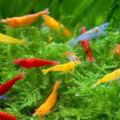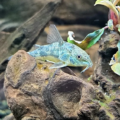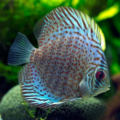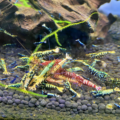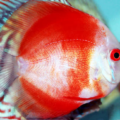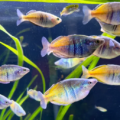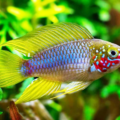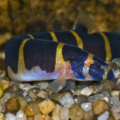The golden look of this fish is a must to behold – With this guide, you get vital knowledge on how to care for this beauty. Learn everything you need to know about keeping the vibrant Golden Discus fish glowing and healthy,

Introduction
If you’re looking for a striking aquarium fish to beautify your tank, why not look at the vibrant aquarium discus.
Whether it’s the bright golden-yellow scales, peaceful temperament, or easy maintenance, this Golden Discus fish overview has all you need to keep this species healthy. I’ve made this guide to Golden Discus care and ownership beginner’s friendly, so don’t stress if it’s your first time with this beauty.
Quick Sidenote: Do you want to watch this article instead of reading it? Checkout the highlight video below from our YouTube Channel (Or read the more detailed article below), be sure to Subscribe For More Great Fishkeeping Content:
Now let’s get straight to business.
Recognizing the Distinctive Appearance of Golden Discus

You can’t miss this unique golden aquarium fish in any tank because of its vibrant scales and color pattern despite its medium size and calm temper. As simple as its identification is, you will miss the Golden Discus if you don’t know the basics of identifying discus fish.
Size
Golden Discus fish typically grow 8 – 10 inches wide and have an almost round shape. Its wide body leaves only small room for its head and short fins.
Color Pattern
A close look at the Golden Discus color details shows you a vibrant, almost glassy yellow hue with reddish-orange fins, translucent fines, and even white spots on their bodies.
We’ll talk more about these patterns and varieties in a bit, but first, you should know how to separate the Discus from other similar-sized and colored species based on their unique traits.
Unique Traits
Do you still wonder what makes this yellow-colored Discus a unique golden aquarium fish? Here’s your answer – they’re peaceful, which makes them social. That means you can include the Golden Discus in a community tank with four or five more fish.
Did you know you can raise a school of golden discus varieties in one tank without diversifying species?
Types of Golden Discus: Varieties to Consider
What’s more exciting than having one color of Golden Discus in your tank? Two or more! That’s right. You can identify different types of Golden Discus with their scale patterns and colors.
Remember I told you we’d dissect the Golden Discus fish variations soon? It’s time!
There are many variants, from the Golden Leopard Discus to the pure Golden Discus, Golden Pigeon Blood Discus, Golden Checkerboard Discus, Golden Albino, and Golden Sunrise Discus.
I’ll highlight two of the most popular variants you will likely find in the market.
Golden Albino Discus

One look at the Golden Albino Discus’s features, and you’ll understand why it’s so popular. Its bright red eyes contrast with its pale pastel yellow scales, which almost appear translucent.
Golden Sunrise Discus

With the Golden Sunrise variant, you’d see a combo of reddish-orange and golden-yellow hues forming a gradient around the fins like a warm sunrise. Now you get the name choice.
Ideal Tank Setup for Golden Discus
Now that you appreciate the physical look of this vibrant fish, it’s time for some much-needed aquarium setup tips for discus keeping and maintenance.
Tank Size and Conditions
Your Golden Discus tank needs come from their Amazonian origins, temperament, and physical features. They need a large tank to hold up to 55 gallons of water per school of five discus.
Then, you must ensure the following parameters.
| Temperature | 82 – 86℉ |
| pH level | 6 – 7 |
| Hardiness | Soft |
Decor and Planting

Next, you must ensure you add Discus-friendly plants and decor to the tank. That means it must be visually appealing yet compatible with your pet’s physical features. Use soft, fine sand, smooth gravel like Dragon Stone, and driftwood.
Also add plants like water lettuce, Anubias, Cabomba, and Carpet Plants to complete the visual representation of the Golden Discus’ natural habitat.
Dietary Needs for a Vibrant Golden Discus
What do they eat? Luckily for you, mastering the Golden Discus nutrition isn’t a challenge. After all, you have the ultimate guide right here.
Food Variety
Invest in high-protein discus food like bloodworms, brine shrimps, blanched spinach, and only high-quality flake or pellet.
For more on feeding your aquatic pets check out The Ultimate Guide to Fish Food: Pros and Cons & Best Choices!
Feeding Frequency
Having the right food isn’t enough; you also need to know the proper feeding schedule for Discus to ensure a healthy life. Feed them twice daily, only in portions they can consume in less than 3 minutes.
Are you ready to add these beauties to your tank now? There are a few more things to know. So let’s wrap it up.
Breeding Tips for Golden Discus
Breeding golden discus fish requires patience and skill, but I’ll simplify it for you in two steps – the breeding environment and fry care tips.
Before getting into it, remember to choose healthy breeding pairs. You can rely on natural selection or choose pairs based on pedigree. Now, you’re ready.
This video has been very helpful in identifying the sex of Discus fish, I highly recommend it:
Breeding Environment
Your breeding Discus breeding tank setup isn’t very different from the regular living aquarium.
Pick a smaller tank of 20 – 30 gallons with a slightly acidic pH of 5.5 – 6.5 and an exact temperature of 82 – 86℉.
A breeding cone for laying eggs in the aquarium
Add a breeding cone amid the live plants for the female Golden Discus to lay her eggs but don’t overcrowd it with decor and substrate. Ensure the water parameters are stable for optimal breeding.
Fry Care Tips
After spawning, the male Discus fertilizes the egg, which can be as many as 100 – 300. After two to three days, the eggs hatch into fry. When caring for discus fry, feed them nutrient-rich mucus from their parents within the first week of their lives.
From the second week, feed them baby brine shrimp and liquid fry food about 4 – 6 times daily. Yes, that’s way more than the adults eat. Remember, kids need all the nutrients to grow, and it’s no different with fish fry.
But that’s not all. You must also ensure you pair your pets with compatible tank mates to prevent stress before and after breeding.
Selecting Tank Companions for Golden Discus
Rummy Nose Tetra | Corydoras Catfish |
Pleco | Ember Tetra |
The ideal tank mates for Golden Discus are species with similar temperaments, environmental needs, sizes, and physical features. Always choose peaceful fish for Discus tanks to avoid conflicts over territory.
Here’s how you can select the right community fish for Discus aquariums:
Compatible Fish
Choose small tetras like Cardinals, Rummy Nose, and Embers. You can also mix up the species in your tank by adding Corydoras Catfish and Plecos.
Avoided Species
Don’t include larger fish like Oscars, cichlids, Barbs, Danios, or bottom dwellers like Loaches. They’re often territorial and would stress your pets.
Preventing Health Issues in Golden Discus
I’ll leave you with some healthy Discus tank tips to ensure you raise your pets in optimal conditions.
Preventative Measures
General aquarium fish disease prevention practice includes maintaining optimal water conditions based on your pet’s needs. Use a quality filtration system to keep the environment clean and ammonia-free.
Signs of Illness
After taking precautions, you must also watch your pets for signs of illness. Golden Discus health care is a simple task when you know what to avoid and how to treat common illnesses. The top signs that your Golden Discus is unhealthy include:
- Difficulty in swimming
- Bloating
- Dull Scales and Coloration
- Clamped Fins
- Difficulty in Breathing and
- Loss of Appetite
See Also: How to Treat Ich Outbreaks in Your Freshwater Fish?
Supporting a Long Life for Your Golden Discus
The good news is that there are tested and tried means of extending discus fish lifespan. Create a routine, as it’ll help you monitor changes in behavioral patterns and tackle them head-on! You see, elongating the lifespan of Golden Discus fish is easy-peasy.
Lifespan Factors
- Tank environment
- Tank mates
- Nutrition
- Health Care
Long-Term Care Tips
I sound like a broken record at this point, but I must emphasize maintaining optimal water conditions and stability.
Next, you must ensure your Golden Discus is eating the right kinds of food.
One more thing, remember that caring for a long-lived discus needs as much attention as new fry. So, don’t forget to clean your tank periodically.
Conclusion
And we’re done discussing everything about Golden Discus care! You can always come back to read this comprehensive guide to vibrant discus maintenance.
If you want more aquarium care tips for discus and other species, you can check out the other guides on this site. Before I leave you, let’s go over the critical points for keeping a Golden Discus one more time:
- Create a Stable environment
- Feed a balanced diet
- Carefully choose your tank mates
- Always perform routine health checks.
You’re ready to be a Golden Discus owner if you can confidently tick this checklist.


